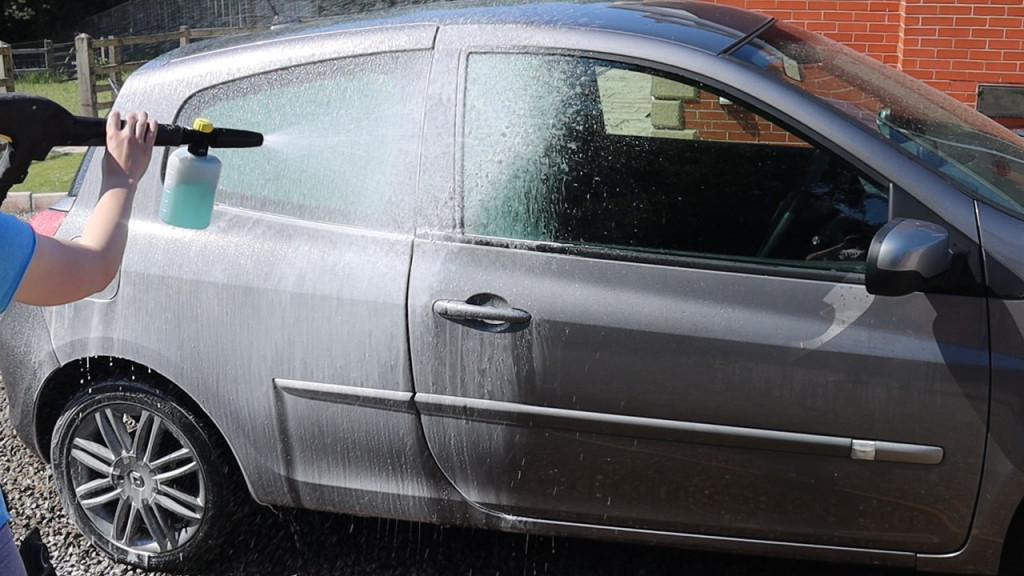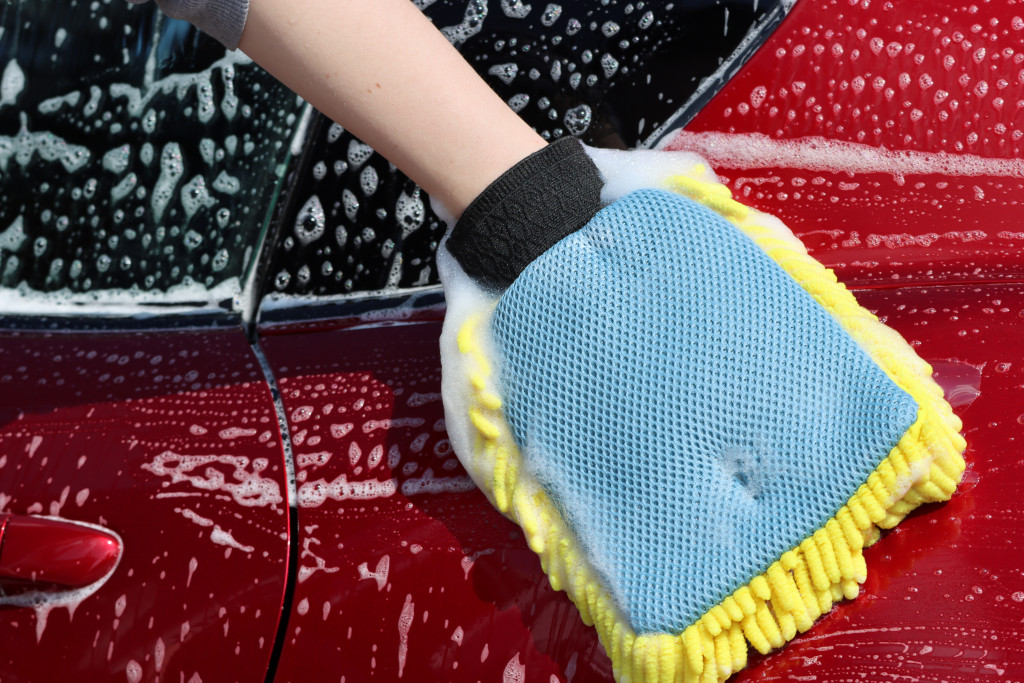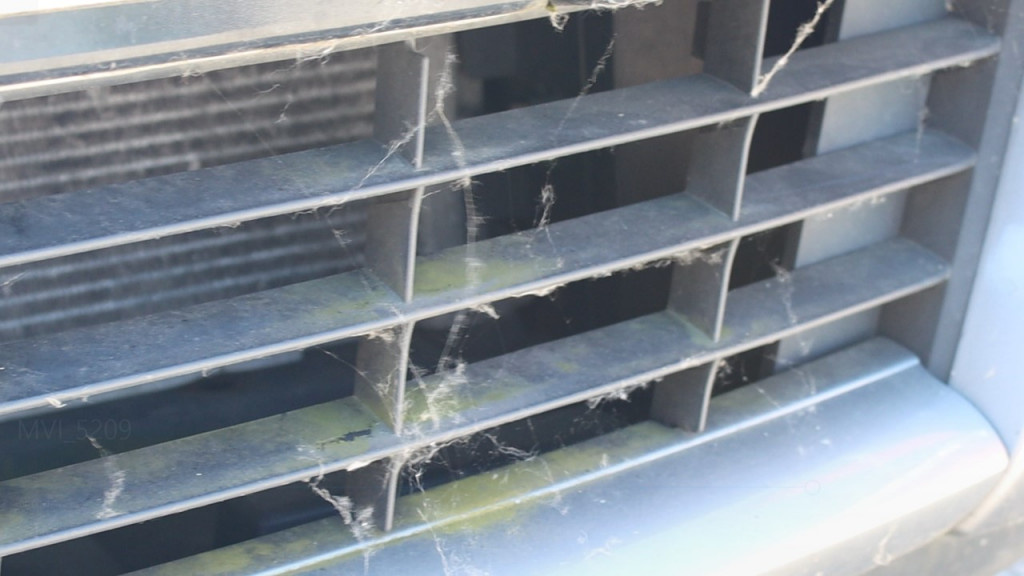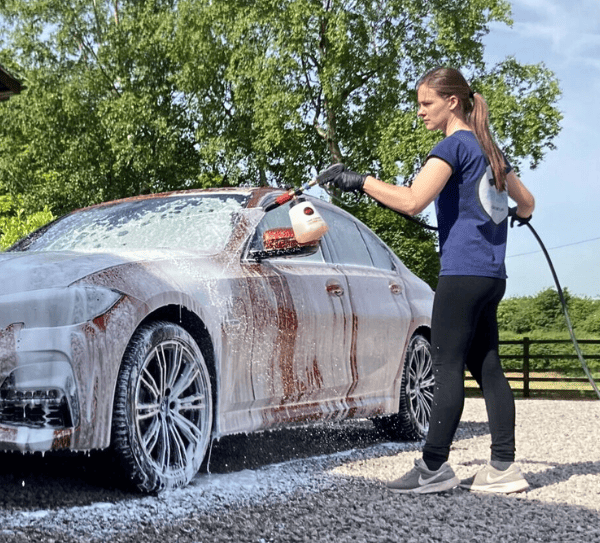If you’re trying to restore an older or neglected car, then you may have noticed that some of the panels, rubber seals and plastic are covered in green stuff. This is usually algae, but can also be mould. It looks terrible, but it’s relatively easy to remove.
In this article, I’ll take you through the step by step guide to removing algae and mould from a car’s paint, rubber, and plastic trim. So let’s get started.
The Quick Answer
You can remove algae and mould from a car’s paintwork by using high-pressure water, snow foam and gentle agitation using microfiber on the paint, and soft brushes on the rubber seals and plastic trim.
How to Remove Algae and Mould (Step by Step)
- Use water to remove as much mould and algae as possible.
- Apply a snow foam or car shampoo to the area to soften it.
- Use a microfiber wash mitt to remove it from the paint.
- Use a soft brush to remove it from the rubber seals and trim.
- Kill any remaining algae and mould using an antimicrobial APC.
- Apply a sealant to the affected area to prevent re-growth.
Here’s a video on the Auto Care YouTube channel where I tackle an algae and mould covered Clio.
What You’ll Need
You’ll need some equipment and products to remove the algae and mould safely.
- Strong all-purpose cleaner suitable for use on a car’s exterior
- Snow foam (or car shampoo if you don’t have snow foam)
- Microfiber wash mitt
- Soft bristle brush (paint brushes can work well)
- High pressure hose attachment or pressure washer
- Snow foam cannon, pump or spray bottle
- Gloves and mask (to protect yourself from the mould)
Looking for some of the best car cleaning products? Make sure you check out my recommended products page for all my current top picks.
1. Assess the Condition of the Car
The first thing you really need to do, is assess the damage and condition of the car. The level of algae and mould present on the exterior, as well as the condition of the vehicle will dictate which methods are safe to use.
If you’ve already had a peek at step 2, then you’ll know that pressure washers can be effective at removing algae from the car’s paintwork in particular.
However, it’s only safe to do so if the paint and trim is in pretty good condition. Otherwise, a pressure washer can actually damage the finish.
2. Use a Pressure Wash (If Safe)
So one very effective method of removing algae, is by using high-pressure washer, either with a hose attachment or a jet washer. However, you can only do this with certain vehicles or you may cause damage.
If the vehicle shows any of the following signs, then don’t use a powerful pressure washer on it.
- Cracking rubber trim or plastic
- Peeling, cracked, or flaked paintwork
- Rust or corrosion
As a general rule, you should only use high pressure water on a car in overall good condition. There shouldn’t be any visible signs of wear and damage that could be aggravated by the power washer.
If you have any doubts, then don’t use high-pressure water on the area or you could cause more damage.
However, if it’s safe to proceed with using a pressure washer then here’s what to do.
- Use a fan-attachment so the pressure isn’t concentrated to one area.
- Position the fan-attachment around 2 meters away from the area.
- Start with medium to low pressure.
- If the algae is not dislodged, then increase the pressure, but do not move nozzle close to the pressure washer.
If this method is not effective, then proceed to step 2. Don’t get too aggressive with the pressure washer or you could cause unnecessary damage.
Take a look at the article I’ve written on how to use a pressure washer safely before using one on your vehicle.
3. Snow Foam the Area
You may be able to soften the algae or mould using a snow foam. This is a chemical designed to dwell on the surface and break down dirt so it can be more easily rinsed away.
Usually, this is best applied using a snow foam cannon attached to your pressure washer. However, you can also use a pump or spray bottle at a push.
I recommend using a snow foam instead of a traffic film remover to remove algae. This is because traffic film removers are often caustic and can promote rusting.
One of my favourite snow foams for removing algae is Bilt Hamber Auto Foam.
If you use a TFR on a car that’s been neglected to the point that it has algae, then there’s a chance some rusting may already have started. So you don’t want to promote this by using a TFR.
Instead, use a powerful snow foam. Bilt Hamber Auto Foam is perfect for this because it has strong cleaning power, but is also more gentle on the paintwork.
If you don’t have a snow foam, then just try it with a car shampoo or your diluted all-purpose-cleaner (designed for use on cars) instead.
Here’s how to use it.
- Mix your snow foam according to the manufacturer’s instructions.
- Apply the foam to the affected area.
- Leave it to dwell for a few minutes (don’t let it dry on the surface).
- Rinse using a pressure washer (if safe) or a hose.
This should either remove the algae entirely, or at least soften it so it can be more easily removed in the next stages.

4. Use a Microfiber Mitt on the Paint
All the methods we’ve tried so far haven’t used any real agitation of the algae. This step involves aggravating the algae and mould so it will be effectively removed from the paintwork.
To do this, you should use a microfiber wash mitt and a car shampoo.
I recommend these products because they are safe to use on the paintwork.
I strongly advise again using a brush or sponge, because they are very likely to cause scratches in the paintwork, and this really isn’t necessary to remove algae. Check out these two articles if you want to find out more.
Microfiber wash mitts are far safer and gentler, but also very effective at removing dirt and stubborn contaminants like algae.
Here’s how to use it.
- Make sure the affected area is wet.
- Lather up the microfiber wash mitt in car shampoo.
- Gently wipe the area.
- Keep checking and rinsing to see if the algae has been removed.
There is no need to scrub at the paintwork. This will risk causing scratches and isn’t necessary because algae is quite easily removed by microfiber.
It’s important to keep rinsing the area so you can assess the situation. You don’t want to keep using the microfiber mitt unnecessarily and rub the dirt and algae back into the paintwork.
If you’re interested in which wash products I use, then check out my recommended car wash products page for my top picks.
It’s also important to keep rinsing the wash mitt to make sure it’s not contaminated as well.
Washing is the biggest cause of clear coat scratches so you need to be really careful whenever you clean your car’s paintwork. Be patient and cautious and you won’t have any issues.
Check out this complete guide to washing your car without causing scratches.

5. Use a Soft Brush on Plastic and Rubber
Algae loves to grow on plastic trim and rubber seals. It’s usually the first place you’ll start to see it appear.
You’ll also probably notice that it likes to gather in hard to reach areas such as cracks, gaps and corners, making it a pain to remove.
The best tool for this, is a soft bristle brush. You’ll want something very delicate as you don’t need a lot of force to remove the algae and mould, you just need something that’ll reach into the tight gaps.
I find that a paintbrush is really effective for this if you don’t own a dedicated detailing brush. So long as it’s soft.
If you do decide to use a paintbrush, apply masking tape around the ferrule so you don’t scratch the paintwork with it.
Here’s how to use a soft brush to remove algae and mould from rubber seals and plastic trim.
- Thoroughly wet the affected area.
- Dip the brush in car shampoo or spray it with your APC.
- Gently use the brush to dislodge the algae and mould.
- Rinse the area to expel any loose algae and mould from the harder to reach areas.
Carefully inspect the area to check you’ve removed the algae and mould and you’re good to go!
Be careful not to let the brush touch the paintwork, or you risk causing scratches. It can be useful to hold a soft, clean microfiber towel around the area you’re brushing so you don’t accidentally touch the paint.
6. Kill the Algae and Mould
Now this is a very important step that you shouldn’t neglect.
Just because the algae and mould has been visibly removed, doesn’t mean that it isn’t still there.
Unless you full decontaminate the area, it’s very likely that the mould and algae will reappear quite soon after this process. So you need to tackle this “invisible contamination”.
So how do you do it?
There are a couple of methods that you can try.
- An anti-microbial all-purpose-cleaner (recommended)
- Isopropyl alcohol (IPA)
The best method is using an anti-microbial all-purpose-cleaner. I say antimicrobial and not antibacterial, because mould isn’t a bacteria. Algae isn’t actually a “microbe” but most antimicrobial cleaners will kill the algae as well.
Simple spray it on the area, leave it to sit for 5 minutes and then rinse thoroughly. Never use it in direct sunlight or high temperatures and don’t let it dry on the surface.
Using an APC specifically designed for exterior use on cars is the safest option to kill any remaining algae or mould. Otherwise, using household cleaners may be too powerful and risk damaging the paint.
Another great option is to use a 50% mixture of IPA. This will kill the algae and mould effectively and is safe to use on both the paint and rubber. Spray it on and wipe the area, then rinse immediately. Do not let the IPA sit on the surface or it can cause it to dry out, fade and crack.
Never use bleach or household cleaners on your car.
They are too aggressive and can stain and damage your vehicle permanently. Take a look at this article I’ve written on why you should never use bleach to wash a car if you want to learn more.

7. Apply a Layer of Protection
The final step, is to apply some protection to the affected areas. There are a couple of reasons why this is important.
- The algae/ mould removal process will have removed any existing protection on your car.
- Adding protection helps to prevent the algae and mould from growing again.
You can protect the paintwork by using a wax, sealant or ceramic coating. Sealants are probably the best choice for this purpose because they’re easier to apply than a ceramic coating, and usually more durable than a wax.
You should also protect the rubber seals and plastic trim. This not only protects it from algae and mould, but also from fading and drying over time.
You can do this by using a trim gel or spray. They’re very easy to apply and can give several months of protection before they need to be reapplied.
It’s very important not to skip this protection step. If you do, then the algae and mould is likely to reappear again after several months.
Quick Note on Prevention
So removing algae and mould from a car’s exterior can be a bit of a pain, and it’s probably not something you’ll want to do again in a hurry. So it’s important to take steps to prevent this from happening again.
If you’ve followed all the steps in this guide, then you’ll definitely slow down the process of the algae and mould returning. But it won’t eliminate the possibility entirely.
The best thing you can do to protect your car from algae and mould is to wash it frequently and keep it protected. Wash your car at least once a month, and you won’t see any algae or mould regrowing.
Then you’ll never have to go through this lengthy process again and your car will look super clean and shiny all year-round!
Related Questions
Here are the answers to some other questions you may be wondering about cleaning heavy contamination off your car.
How do you remove moss from windows and seals?
You can remove moss from windows and rubber seals by using a power washer to dislodge the moss. Then use a soft bristle brush and a all-purpose-cleaner to remove any remaining moss. Rinse the area and dry thoroughly.
How do you prevent algae, moss and mould from growing?
It is possible to prevent algae, moss and mould growing on your car by washing it regularly (at least once per month), and applying protection in the form of a sealant or wax to the paint, and a trim dressing to the rubber and black plastic.
What is that green stuff on my car?
Usually, the green material growing on a neglected vehicle is algae. It accumulates in humid conditions and is often present on cars which are rarely washed. Sometimes the green can also indicate mould, however this tends to be less common.
Thanks for reading! I hope you’ve found this article helpful. Check out the rest of the website to learn more about restoring and protecting your vehicle.

